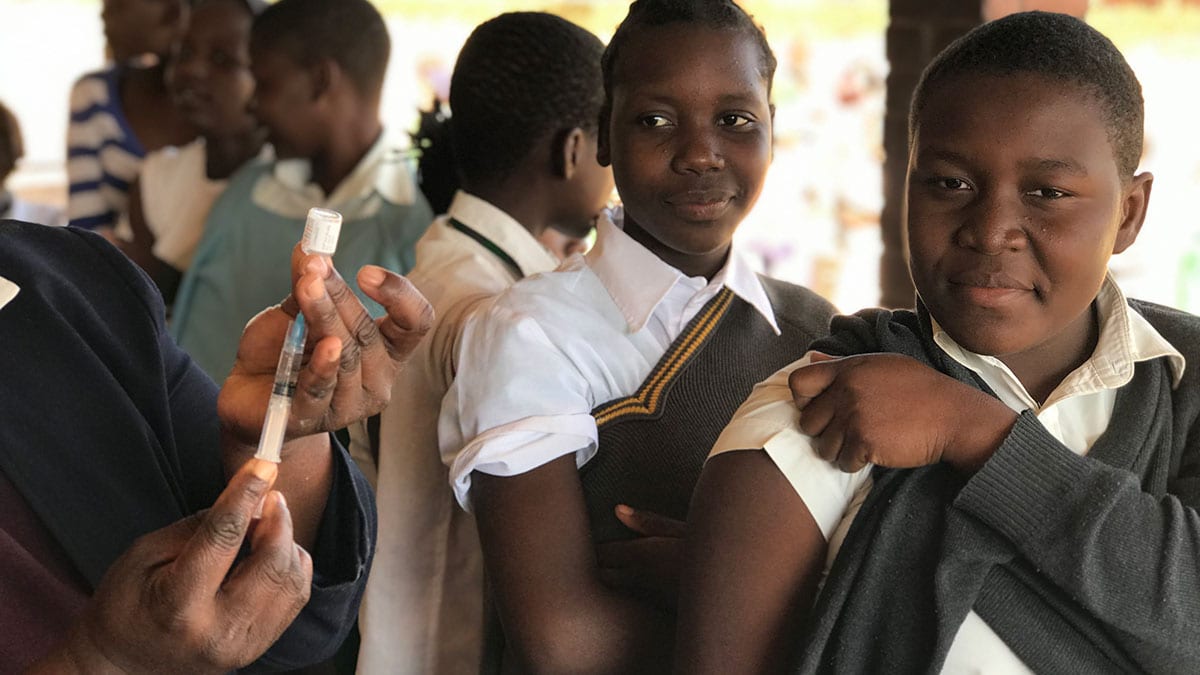Key points
Cervical cancer claims the lives of over 300,000 women worldwide each year – one woman every 2 minutes. Most of these women live in low- and middle-income countries. The World Health Organization (WHO) recommends vaccination, screening, and treatment to prevent and control cervical cancer. The HPV vaccine is the best tool to prevent HPV infection. HPV vaccines are safe and can prevent almost all cervical cancer cases.

Pilot programs
Zimbabwe, Senegal, and Tanzania
In Zimbabwe, Senegal, and Tanzania, cervical cancer is a leading cause of cancer among women. To better understand the feasibility and acceptability of new vaccine strategies for nationwide implementation, each country launched a pilot program to reach adolescent girls, who are not traditionally reached through childhood vaccination programs.
Recognizing the opportunity to prevent unnecessary deaths, these countries subsequently decided to introduce the HPV vaccine nationwide for all girls. They are among some of the first low- and middle-income countries to introduce the vaccine on a national scale.
CDC and global partners evaluated the national HPV vaccination programs in Zimbabwe, Senegal, and Tanzania to gain lessons learned in program implementation, cost, best practices, and challenges. This research can inform future planning and continued improvements of HPV vaccine introduction in other low- and middle-income countries.
Tailored strategies
Through tailored strategies to introduce the HPV vaccine, each country developed a plan to reach girls between the ages of 9 and 14. School-based vaccination campaigns and routine immunization delivery were selected based on school enrollment, financial considerations, and strength of routine immunization programs already in place.
Results
All three countries reported high uptake of the HPV vaccine through both the school-based campaigns and routine delivery. Critical to the high vaccine coverage in each country was strong political commitment and cooperation across multiple sectors, including health and education. Strong evidence on vaccine effectiveness and safety of the HPV vaccine was integral to the decision for nationwide introduction in each country.
Each country also noted challenges and missed opportunities for vaccinations. Lack of knowledge among a small number of healthcare workers and families led to misunderstandings about the HPV vaccine. Vaccine hesitancy was also reported in each country, potentially slowing vaccine coverage. Communication plans were used to combat misinformation and address rumors. Strategies such as widespread social mobilization and education of healthcare workers, teachers, and community members helped to maintain high coverage.
Looking ahead
Moving forward and continuing HPV vaccination efforts requires improved understanding, engagement, training, and communication with partners and across sectors. The CDC evaluation, following HPV vaccine introduction, showed that most healthcare workers and teachers had a good understanding of the HPV vaccine. Healthcare workers and teachers are trusted community members, which made them a valuable resource for campaigns in schools and community settings.
Further efforts must also prioritize health education about HPV vaccination among girls within the desired age group. Communication strategies, including social media, are critical to education, community engagement, and vaccine acceptance. In feedback received through the evaluation, a healthcare worker in Senegal recommended "strengthening media coverage, including radio and television, increasing training for community health workers on HPV, and making communication support available."
When introducing new vaccines, financial feasibility must be considered to build sustainable programs. Following the pilot programs, CDC and partners evaluated the cost of introducing the HPV vaccine in Senegal and Zimbabwe, filling a necessary knowledge gap that can help inform future HPV vaccine introduction and planning in other countries.
In Senegal and Zimbabwe, cervical cancer can be prevented for less than $4 per person.
Community engagement and cost consideration help build sustainable HPV vaccination programs.
Considering costs only at the district and health facility levels, Senegal's introduction and routine delivery approach resulted in a financial cost per dose of $2.69, whereas Zimbabwe's introduction and campaign delivery financial cost per dose was estimated at $0.53. Both estimates exclude the price of the vaccine and injection supplies. In Senegal, when the costs at national and regional levels were also considered, the financial cost was $3.07 per dose, which will decrease as more girls are vaccinated and the initial investments yield benefits over time. The lower financial cost per dose in Zimbabwe reflected the campaign approach of vaccinating a larger group at once, mainly at schools; however, additional efforts to vaccinate out-of-school girls in Zimbabwe increased the financial cost per dose to $3.52 per out-of-school girl, indicating that intensified higher-cost efforts may still be needed to make vaccination accessible to all.
Public health implications
Without changes in prevention and control, cervical cancer deaths will rise to over 400,000 per year by 2035. More than 100 countries have introduced the HPV vaccine as of 2020, and continued use will reduce HPV infection and cases of cervical cancer.
The programs in Zimbabwe, Senegal, and Tanzania serve to inform future immunization programs through lessons learned and recommendations. Increasing HPV vaccine demand and coverage and building sustainable programs protects women across the globe from cervical cancer.
